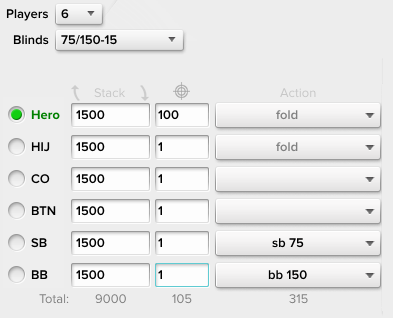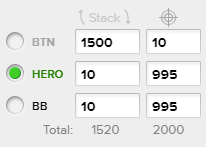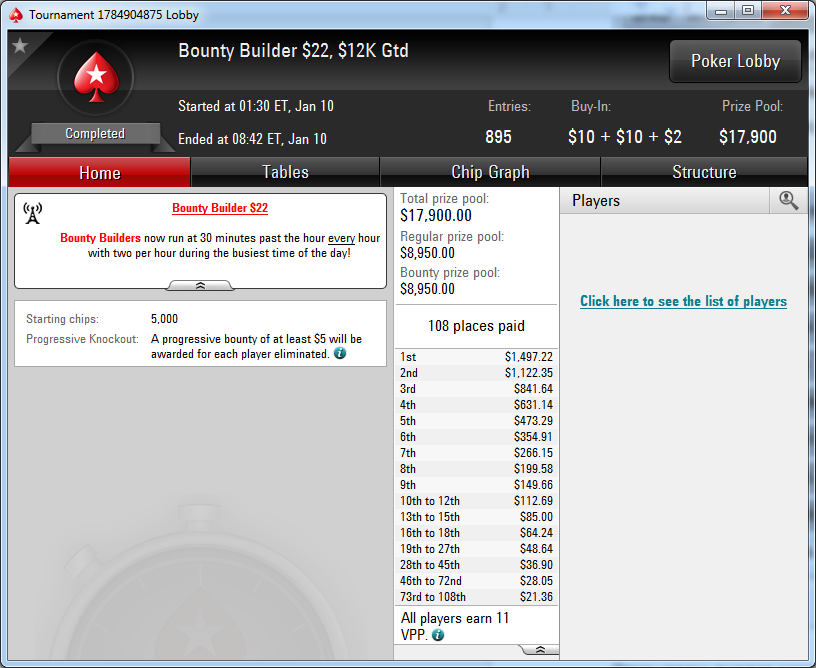How Progressive Knockout (PKO) tournaments are different
Progressive Knockout (PKO) tournaments are a type of knockout tournament where your immediate reward for knocking out an opponent is half their cash bounty. The other half is added to your own bounty, to be collected by whoever eventually knocks you out. The winner of the whole tournament is the only player who collects their own bounty in the end.
This means that in a PKO tournament your bounty grows with every player you eliminate. Contrast this to regular KO tournaments, in which each player’s bounty is a fixed amount that does not change throughout the tournament regardless of how far they advance.
TrueBounty model for analyzing PKO tournaments
TrueBounty model — a proprietary model for bounty tournaments available only in ICMIZER. The model supports up to 100 players remaining in Bounty tournament because of its complexity which ensures superior precision compared to ultra-fast Chip EV bounty (Proportional) model but takes a longer time to run. TrueBounty model provides a significantly better approximation of results which can be achieved by Monte-Carlo simulation compared to the simplistic approach of Chip EV (Proportional) bounty model.
Chip EV Bounty (Proportional) model — a simplistic model which overvalues big stacks and undervalues short stacks. The formula for calculation of players bounty part of stacks equity is simple:
Stack $EV = ChipsInStack / TotalChipsInMTT × RemainingBountyPool
The model is used for situations with more than 100 players remaining because the preferable TrueBounty model is not available in these situations due to its complex formula.
Because of their complicated payout structure, PKO tournaments present the biggest EV calculation challenge among all of the tournament types supported in ICMIZER. To give you accurate answers, the model must know not only the player stack sizes, but also the current bounty for each player and the full tournament prize structure (how much each place gets at the end).
Pure Chip EV calculations are meaningless in PKO, as the individual player bounties can drastically change your plays at any point. This is why, when you analyze PKO in ICMIZER, you should only use ICM %EV or ICM $EV modes.
As the number of players at the table increases, the complexity of calculations behind our TrueBounty model needed to convert PKO tournament data into equity grows exponentially, and so does the time it takes. Owing to these computational demands, with our major update 3.2.0 ICMIZER can perform calculations for up to 100 players remaining in Bounty MTT.
The Future Game Simulations (FGS) model is even more computationally expensive when applied to PKO tournaments. FGS is currently available for up to eight players at the final table.
Counterintuitive PKO: Who really owns my PKO bounty?
Imagine this final table in a PKO tournament:

There are 6 players left. Hero has knocked out every other player so far and his bounty is $100. Each of the other five players is still at their initial bounty of $1.
Who would you rather be, in terms of equity in the tournament prize fund: Hero or one of the other players?
Intuition may be telling you that, since Hero cannot knock himself out, he ‘owns’ a smaller share of his own $100 bounty. It’s only some of the other players’ $1 bounties he might realistically be looking to collect.
You may even want to run some calculations and find out that the HIJ or the BB is in a better position than the UTG (not taking into account the knockout bounties Hero has already collected, but only considering the current EV of each player’s stack).
However, the correct answer is this: All players have the same EV at this point. They own identical shares in the total PKO bounty pool, proportional to their stack size but independent from any bounty amounts.
Hero has a chance to collect his own bounty if he finishes first. Since his stack size is equal to all the others’, his odds of winning the tournament are ⅙. His chances of not collecting his own bounty are ⅚. That’s the same as the chances the five other players have of collecting it, all split equally. Therefore, each player has a ⅙ equity in Hero’s bounty, including Hero.
An important consequence is that at the early stages of a PKO tournament, you should not be interested in raising your own bounty (or, conversely, trying to keep it the same) without collecting the bounties of other players. Unlike a regular KO tournament, you’re only getting half the cash rewards for eliminating opponents. This means that, assuming equal bounty amounts, knocking opponents out is only 50% as lucrative in PKO as it is in regular KO.
So is our Bounty Pool Equity equal to our chip EV equity?
That would definitely be very convenient. And look, it is equal to chip EV equity in the example above when all stacks are equal! So it should only be natural for it to be true? It would allow us to assign PKO equities for fields of infinite size covering the largest MTT Bounty tournaments.
Here is an example that demonstrates that everything is much more complex. Not only our Bounty Pool Equity is not based on the Chip EV equity, but it also depends on how exactly bounties are distributed at different players.

While the Button has 150x more chips more than 2 other short-stacked players, it should be obvious that he can hardly expect to get his Chip EV part of the 2000$ bounty pool which would be equal to 1500 / 1520 × 2000$ = 1974$ if the chip EV based approach was correct.
In reality, it should be obvious that there is no way for BTN to stop SB and BB players from having a great chance to bust one another and immediately gain ~500$ part of the bounty prize pool or 25% of it regardless of their super short stacks.
According to ICMIZER' PKO model, the stacks in this situation have the following values
Fig 1. Equities according to TrueBounty model in ICMIZER
| Stack |
Bounty
| Equity %
| Equity $
|
| 1500 |
10$ |
86% |
1720$ |
| 10 |
995$ |
7% |
140$ |
| 10 |
995$ |
7% |
140$ |
Fig 2. Equities according to simplistic Chip EV approach (Proportional model)
| Stack |
Bounty
| Equity %
| Equity $
|
| 1500 |
10$ |
98.68% |
1974$ |
| 10 |
995$ |
0.66% |
13$ |
| 10 |
995$ |
0.66% |
13$ |
As we can see, the Chip EV (Proportional) model undervalues short stacks by 900% or sells them 10x cheaper than a more sound approach. The big stack also is valued incorrectly, there's a significant difference between 1974$ and 1720$ in this scenario.
What's funny about the Chip EV approach is that it ignores how the bounties are actually distributed, it just sums them up and works with the sum.
Let's swap bounty for the big stack and short stack and look at the bounty pool equity with the ICMIZER Bounty model:
Fig 3. Equities according to TrueBounty model in ICMIZER if BTN and SB swap their buttons
| Stack |
Bounty
| Equity %
| Equity $
|
| 1500 |
995$ |
92.57% |
1851.4$ |
| 10 |
10$ |
6.73% |
134.6$ |
| 10 |
995$ |
0.70% |
14$ |
Here we can notice a couple of very interesting changes.
First, now that the big stack holds big bounty his equity is way closer to his Chip EV equity than in the previous example.
Second and way more important, we can see that while SB and BB stacks are equal, their equities are not. In Chip EV approach (Proportional model) the equities of the same stacks are always the same due to the simplistic formula used in Chip EV (Proportional) bounty model.
To see why SBs equity is almost 10x BBs equity, we need to consider how they can try to realize their bounty equity. The player on the BB position would need to bust the big stack in order to get anything other than a mere 5$ for busting SB. The chances of that outcome are very slim of course.
The SB, however, can bust BB with a reasonable probability and immediately get half of his bounty. He would require insane luck to try to get a bounty from the BTN though, that's why his EV is approximately worth 1/3 × 500$ or 137$.
We can now infer the following important feature of bounty tournaments: in progressive bounty tournaments players with the same stacks do not have the same equity unless all stacks are the same. So a good model should demonstrate different equities like in the example above, while the naive chip EV based approach would produce the same EV for SB and BB in the example on Fig 3, which should be enough for professional players to prefer a more precise model which is offered with ICMIZER.
Differences between PKO and KO strategies
In regular KO tournaments, each player’s bounty is the same at every stage. You earn the same knockout bounties at the very start of a 2000-player tournament as you do at the final table. At the early stages the bounty amount represents a significant part of your stack EV, which means that early knockout opportunities weigh heavily in your playing decisions. Towards the late stages though, the bounty represents an ever diminishing portion of your EV and its impact shrinks. Your goal becomes to place as high as possible and get a bigger prize than to knock someone out.
The strategy dynamics are different in a PKO tournament. At the beginning you’re equally interested in knocking opponents out because the PKO bounty pool is typically 50% of the total prize fund, compared to only about 20% in KO tournaments. This larger bounty size roughly evens out the 50% knockout penalty and makes early knockouts as lucrative in PKO MTTs as they are in KO.
It’s worth noting that some players go with their intuition and make the mistake of playing tighter than necessary early in a PKO tournament. The truth is there’s a lot of value in collecting early knockout bounties in both KO and PKO.
However, at the late stages of a PKO, the average bounty size goes up considerably, making knockouts play a higher role than they do in KO. Given that same stack sizes can come with bounty amounts that vary wildly, your late PKO strategy may be very different from your late KO strategy. This applies even if the only difference is in the positions and amounts of the bounties.
At the late stages, intuition also comes into play forcing many players to err on the loose side and try to knock out opponents. This kind of play can cost you very dearly in a KO tournament, and the same is true for PKO if you go after players who haven’t beefed up their bounty much since the start of the tournament.
In a PKO tournament, the winner collects their own bounty, that of the runner-up, and a few more along the way. A shot at these juicy bounties means that finishing first has higher priority in PKO.
While intuition is important and a good ‘skill’ to have, it is simply not good enough to make optimal decisions at all the different stages in a PKO tournament. To take all the factors into account and calculate your plays correctly, you really need the right software, i.e. ICMIZER. (Hey, you can work on your intuition too, but you’ll have much better results if you do it by analyzing hundreds of games with help of TrueBounty model!)
How to analyze PKO hands in ICMIZER
To work out a highly effective strategy for Progressive Knockout tournaments, you should select two key ICMIZER settings: PKO tournament and hand details and the bounties.
Suppose you want to analyze one or more hands from a PKO tournament that isn’t available in ICMIZER yet. Then your first step is to create a new PKO tournament in ICMIZER. Your second step is then to load a hand with the PKO bounties, assign ranges and get push/fold charts for Hero.
After you create a PKO tournament, there will be boxes for entering each player’s bounty. You can fill these in manually, or save time and load a hand from the PKO tournament as text. That way all the stack sizes and bounties will be populated for you automatically.
Let’s look at these two steps in more detail.
Step 1: Create a new PKO tournament in ICMIZER based on a real tournament
For accurate analysis, it’s crucial to set up the number of players, initial knockout bounty size and the payouts for the first nine places. Another important detail is the ratio of prize fund and the knockout bounty pool. For example, in most PokerStars tournaments these are related as 1 to 1.

Let’s go through creating a Bounty Builder $22 tournament, as on the screenshot above.

We open the ‘Add new tournament structure’ dialog and select the ‘Progressive’ check-box. Then we set ‘Number of players’ to 895, ‘Knockout size’ to 10, and enter the payouts for places 1 through 9.
By entering these amounts, we’ve allocated $14,485.94 of the prize fund, even though the prize fund total is $17,900. Now we have two options for entering the remaining payouts:
Full entry for all in-the-money tournament places. If you go through with this, the calculations will certainly be accurate, but it will take a while. The only thing these additional payouts really influence is the prize fund total.

The screenshot above shows that all payouts have been entered as they were in the real tournament, and the prize fund total is precisely $17,900. Now can you click Create and start analyzing the final table.
-
Simplified entry. The precise payout values for places 10 through 108 will only affect the prize fund total, or rather its non-bounty-related portion. Simplified entry is just faster without compromising overall accuracy.
So, for place 10, enter an approximate amount such as $100. Then widen the place range, for example from “10” to “10-43”, so that the prize fund total is very close to $17,900. (A small discrepancy of about $20 will not compromise overall accuracy.)

As you can see on the screenshot above, we’ve created a range of $100 prizes and the prize fund total is $17,885.94, which is very close to the real value of $17,900. Now we can click Create and start the analysis. The results we’ll get this way will be, for all intents and purposes, the same as if we had chosen to do ‘Full entry.’
As you can see on the screenshot above, we’ve created a range of $100 prizes and the prize fund total is $17,885.94, which is very close to the real value of $17,900. Now we can click Create and start the analysis. The results we’ll get this way will be, for all intents and purposes, the same as if we had chosen to do ‘Full entry.’
Important! If you fail to go through with either of these two options and only enter the first 9 payouts, the prize fund total will be incorrect and the analysis will produce inaccurate results.
After you finally click Create, the newly created PKO tournament will have this icon next to it:

Step 2: Load a hand and identify the best strategy in a PKO tournament
After you open a PKO tournament, a new column will appear for entering each player’s bounty amount (look for the scoped target symbol to the right of the Stack column):

You can enter the bounties manually, or you can simply load hands from PokerStars as text. They recently added bounty data to their hand exports, which makes setting up the analysis much easier.
When the tournament is down to 9 players or fewer, ICMIZER is able to utilize the power of the FGS model in combination with TrueBounty model for analyzing PKO tournaments.
After you create a PKO tournament, analyze hands in exactly the same way as you do for regular tournaments. Just make sure you’ve entered the bounties for each player, and go ahead.
Hand analysis goes like this:
- Enter a hand, for example by loading it as text (click ‘Paste hand history’).
- Assign opponent ranges, for example by clicking ‘Calculate Nash equilibrium,’ or manually, or by combining both methods.
- Get results — click ‘Calculate’ to get the push/fold charts for Hero, or click ‘Charts’ to see how your decision depends on the ranges of one of your opponents.
In conclusion
ICMIZER is the first poker calculator on the market that lets you analyze PKO tournaments with FGS. We’ve worked hard to bring you this functionality and optimize the performance of our algorithms, so that you could identify mathematically proven optimum plays in this complex type of tournaments.
The right strategy in Progressive Knockout tournaments may vary from one stage to another and go through exciting and sophisticated dynamics. This is true for novices and experienced players alike. Arm yourself with ICMIZER to make counterintuitive yet accurate plays and gain the upper hand over your unsuspecting opponents, every step of the way.